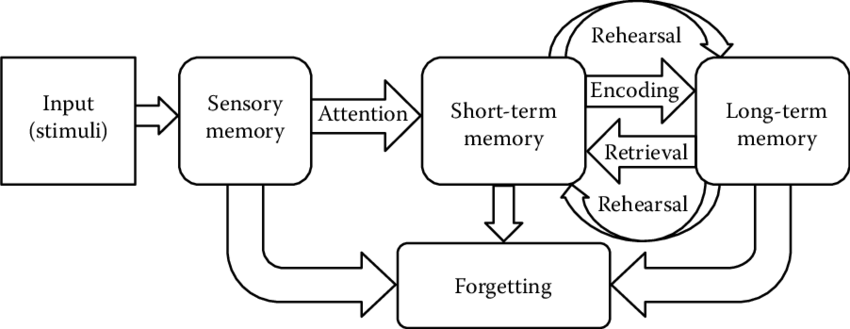Learning and Memory - Exam 3
1/18
There's no tags or description
Looks like no tags are added yet.
Name | Mastery | Learn | Test | Matching | Spaced |
|---|
No study sessions yet.
19 Terms
What is sensory memory and its key characteristics?
Initial, ultra-brief storage system lasting 0.5-3 seconds, with large capacity but most information lost, operating automatically without conscious control
What is working memory and its components (Baddeley's model)?
Active system for maintaining and manipulating information, helping with multitasking and planning. Components include:
Central executive (controls attention)
Phonological loop (verbal/auditory)
Visuo-spatial sketchpad (visual/spatial)
What is long-term memory (LTM)?
Brain's system for storing and retrieving information over extended periods, working with prefrontal cortex for retrieval. Information must be properly stored first
Compare iconic and echoic memory
Iconic memory is brief visual sensory memory acting as information buffer, while echoic memory holds sound information for 3-4 seconds, maintaining exact copy without interpretation
What's the difference between transient and permanent memory?
Transient memory is short-lasting (seconds to minutes), requiring active maintenance through rehearsal. Permanent memory persists indefinitely after proper consolidation and is more resistant to disruption
Describe Atkinson and Shiffrin's model
Three distinct stores:
Sensory memory (information entry)
Short-term memory (temporary holding via rehearsal)
Long-term memory (permanent storage) Information flows from sensory to STM to LTM through rehearsal

What is depth of processing?
Analyzing information more deeply leads to better encoding and remembering. Deep semantic processing (like generating mental images) results in better memory than superficial processing
What is transfer-appropriate processing?
We remember things better when test conditions match learning conditions (e.g., learning with pictures leads to better recall when tested with pictures)
What are the three key declarative memory processes?
Encoding (initial processing, converting sensory input)
Storage (maintaining information, creating lasting representations)
Retrieval (accessing stored information, bringing memories to consciousness)
Compare free recall vs. recognition
Free recall involves generating information without cues, while recognition involves selecting from multiple options. Recognition typically yields better performance (85-90% vs 20-50% in classmate name study)
What are the stages of skill learning?
Cognitive stage (conscious attention, mistakes)
Associative stage (performance improves, errors decrease)
Autonomous stage (performance becomes automatic)
Compare perceptual-motor vs. cognitive skills
Perceptual-motor skills are physical abilities requiring coordination and sensory input, becoming automatic with practice. Cognitive skills are mental abilities requiring thought and planning, may still need conscious effort when mastered
Compare Parkinson's, Huntington's, and ADHD brain differences
Parkinson's: affects basal ganglia and dopamine neurons in brainstem
Huntington's: impacts basal ganglia and cerebral cortex
ADHD: involves smaller right prefrontal cortex and prefrontal cortex connection dysfunction
What is task-switching and how is it studied?
The ability to alternate between tasks while maintaining focus. Studied using Wisconsin Card Sort Test, where participants must adapt to changing sorting rules (color to shape)
What are key memory tasks and experiments?
Tower of Hanoi: tests planning and working memory
Stroop task: tests response inhibition
DNMS: tests working memory and recognition
Bransford and Johnson's study: shows importance of context in memory
What is the Tower of Hanoi test?
A puzzle that tests planning and working memory where players move disks between three poles following specific rules - can only move one disk at a time and cannot place larger disks on smaller ones. It evaluates executive function by requiring players to maintain and update subgoals in working memory.
What is the Stroop task?
A test where participants must name the color of ink that words are printed in while ignoring the written color words (e.g., "green" printed in red). It tests response inhibition and the ability to maintain goals while suppressing automatic responses.
What is the Delayed Non-Match-to-Sample (DNMS) task?
A memory test where subjects are shown a sample stimulus, then after a delay must choose between the original sample and a new stimulus. To succeed, they must select the new (non-matching) stimulus. This tests working memory capacity, recognition memory, and object discrimination.
What is the Bransford and Johnson contextual memory study?
A classic experiment showing how context affects memory and comprehension. Participants who saw a contextual image before reading an ambiguous passage had much better recall than those who saw the image after or not at all, demonstrating that context is crucial for organizing information in memory.